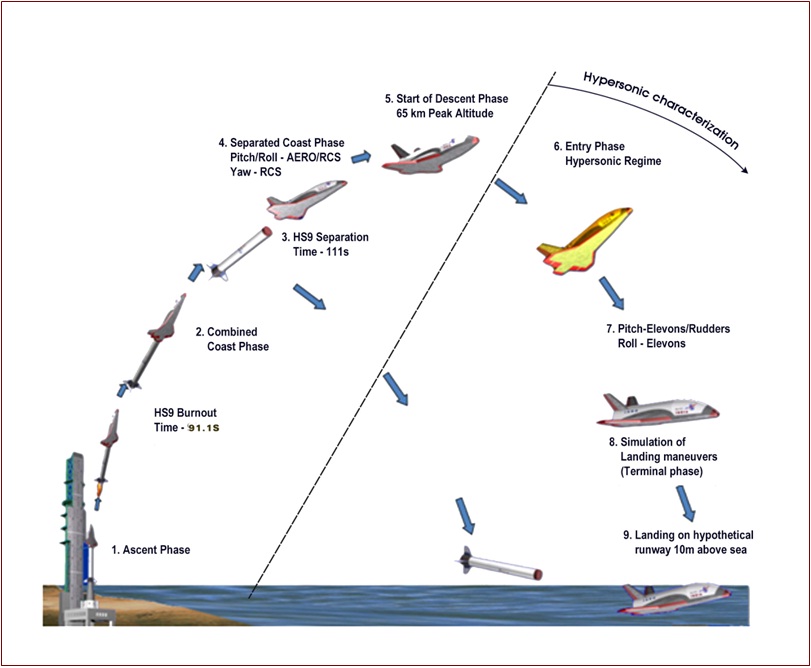The Indian Space Research Organization (ISRO) has revealed that it has been working on a new test vehicle with an integrated scramjet engine. Speaking at the 21st Annual CFD Symposium at CSIR-NAL organised by the Aeronautical Society of India held in August 2019, Dr Dipankar Das (ACMD, VSSC, ISRO) stated that the design of a new vehicle with an integrated scramjet engine, to build on the success of the first test conducted in 2016 is underway and is expected to be finalized soon. Before we turn to some exclusive details of the demonstrator configuration under consideration, let us take a brief look at the evolution of ISRO’s air-breathing engine efforts.
Background on ISRO scramjet technology
Contemporary satellite launch vehicles (SLVs) which are basically multi-stage rockets incur a payload penalty by having to carry an oxidizer along with fuel. As such, countries around the world have been investigating air breathing engines to lift payloads into space more efficiently and India is no exception to this trend. Indeed, ISRO successfully flight tested a scramjet engine design back in August 28, 2016 itself in furtherance of this goal.
During the August 2016 test, the two scramjet modules carried on board a sounding rocket reached a flight speed of greater than Mach 5.5 at altitudes of 35 km and 38 km with a dwell time of 5 seconds. After a total flight time of about 300 seconds, the carrier vehicle itself touched down in the Bay of Bengal, approximately 320 km from Sriharikota. Scramjet combustion during this test was achieved while the carrier rocket had essentially begun coasting with its own solid motor having burnt out. Interestingly, most scramjet tests by other nations have been conducted at lower altitudes. As such, ISRO’s scramjets produced 2287-4629 N of thrust each during the 2016 test and this was in line with what modelling had predicted. In fact, these scramjets continued providing thrust for a further 14 seconds in blow-down mode during the test. Importantly, pressure distribution along the engine floor was found to match predicted values.
Auto-ignition at supersonic speed, stable flame-holding the flame at supersonic speed, pyro-actuated air intake cowl opening mechanism and fuel injection systems were some of the critical technologies that were successfully demonstrated in the 2016 test. Developing computational tools to simulate flow and combustion at hypersonic speeds, materials capable of withstanding intense thermo-mechanical loads and setting up testing facilities such as hypersonic wind tunnels were some of the challenges that had to be overcome before the test was successfully carried out.
The experiment was conducted in what ISRO calls an ‘air breathing flight corridor’ (ABFC), which is a sort of ‘optimal’ altitude band for testing air-breathing concepts. It is ‘optimal’ because above the ABFC one would find ‘too little’ air to achieve combustion while below it there would be ‘too much’ in the sense that the engine would be subject to extreme thermal-structural loads. During the flight test, upon reaching test conditions, the intake cowl was pyrotechnically opened followed by feeding of pressurized hydrogen fuel. Inlet start occurred followed by flow shocks establishment. Air flow stabilization after intake cowl opening was observed faster than predicted. Fuel injection and subsequent auto-ignition were observed from on-board pressure measurements and instrumentation. To ascertain if auto-ignition occurred during flight testing the igniter was initiated with a 2.2 second delay. The oxyacetylene based igniter was added as a backup in case auto-ignition did not occur during the flight test. Near simultaneous auto-ignition was observed in both engines with instruments registering a spike in acceleration immediately thereafter.

Fig 1: RLV-TD Flight profile. Source: ISRO Link
The Future
ISRO wishes to employ scramjets on future Single Stage To Orbit (SSTO) and Two Stage To Orbit (TSTO) missions. These missions would in the future employ rocket or turbine based combined cycle engines. As mentioned above, ISRO is now working towards a bigger scramjet demonstrator in the near future. The outline of the test vehicle is given in Fig 2, right below:


Fig 2: Barebone Schematics of ISRO’s new proposed scramjet test vehicle, based on an ISRO presentation made during the 21st Annual CSIR-NAL CFD Symposium.
Overall, ISRO says that it has studied more than a 100 different configurations to arrive at this particular outline. This new demonstrator is expected to be a 3.23 ton vehicle which will cruise at speeds of Mach 6 to Mach 7 and at altitudes between 24 km and 26 km. The scramjet that will power the flight vehicle is an evolution of the design tested in 2016 and will operate for 200-250 seconds while providing much greater thrust. Although, the first test in 2016 was conducted with Hydrogen as fuel, Kerosene will be employed going forward. Though Hydrogen is a cleaner burning fuel resulting in only hydroxides and water emissions, Kerosene is being preferred since it is denser and does not pose handling difficulties unlike liquid Hydrogen. It also has a lower auto-ignition temperature of 220 °C as compared to 500 °C for Hydrogen. It is noteworthy, that extensive studies were conducted on Kerosene combustion in collaboration NIICHIMASH, Russia. The new vehicle is expected to be statically and dynamically stable.
© Delhi Defence Review. Reproducing this content in full without permission is prohibited.
































